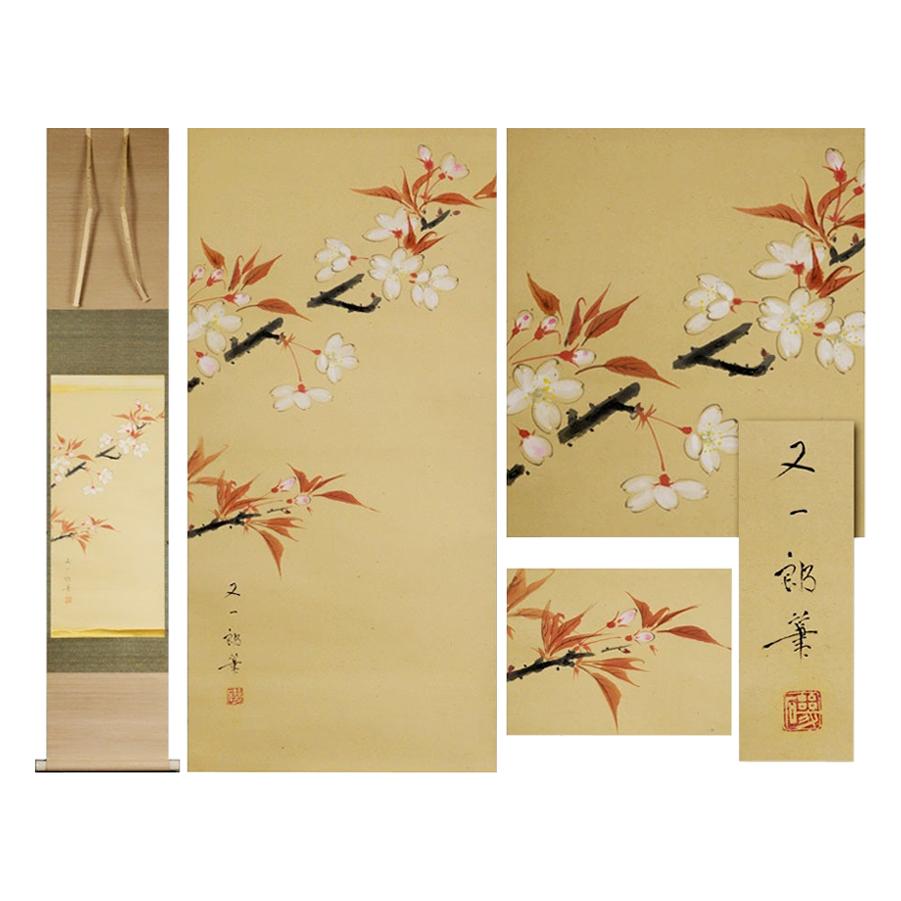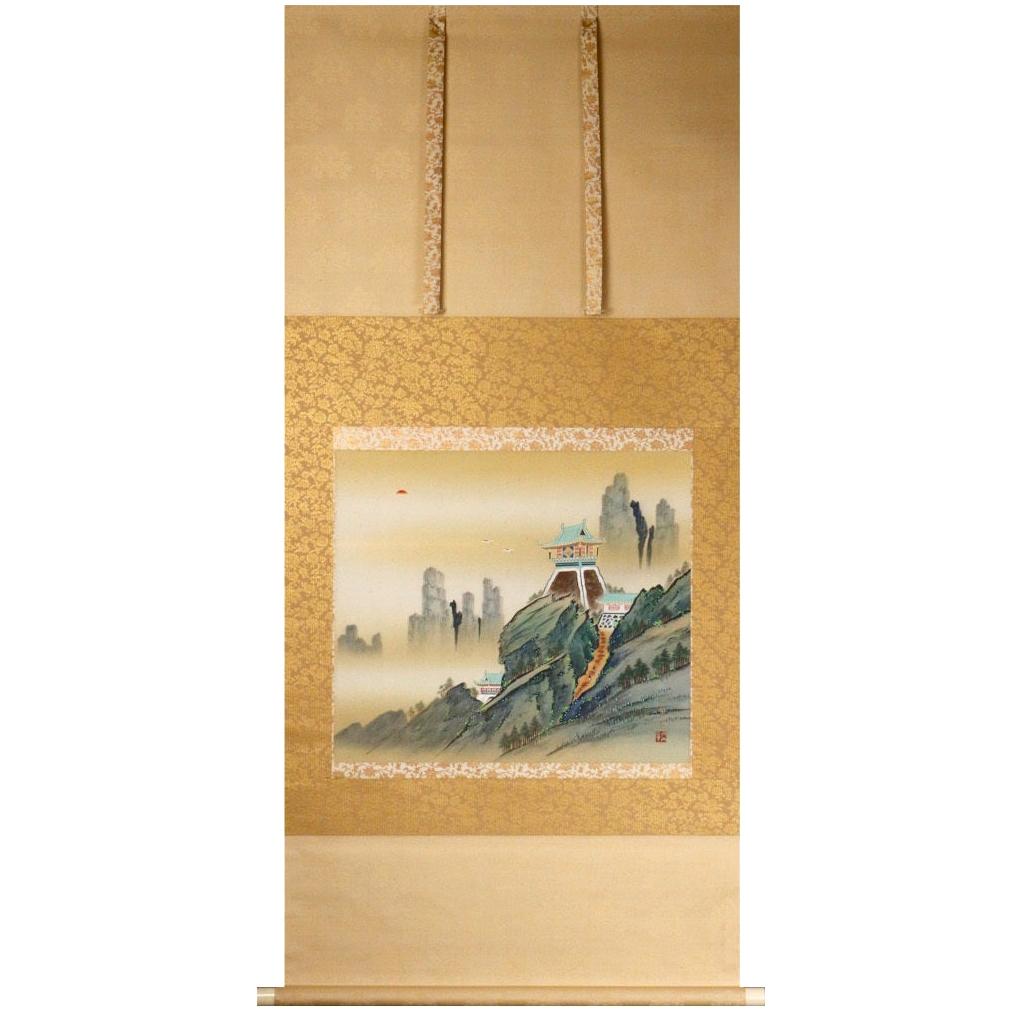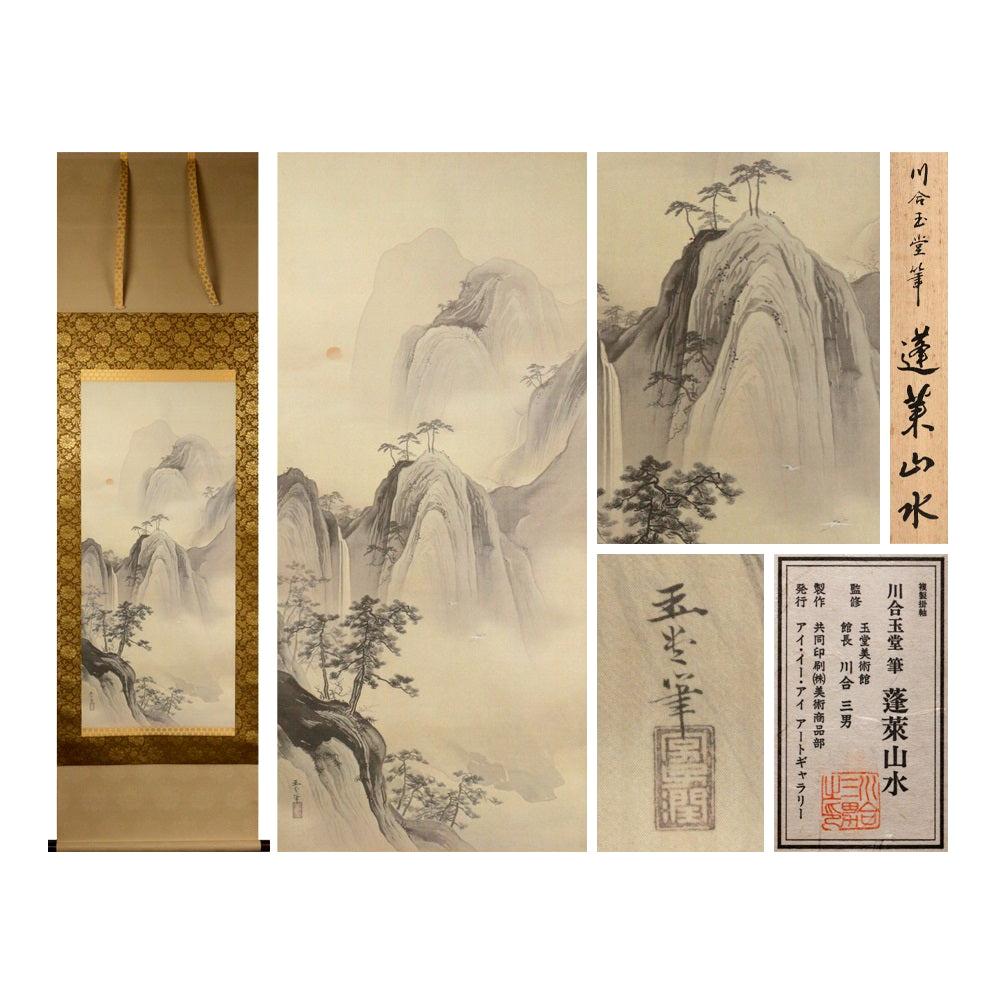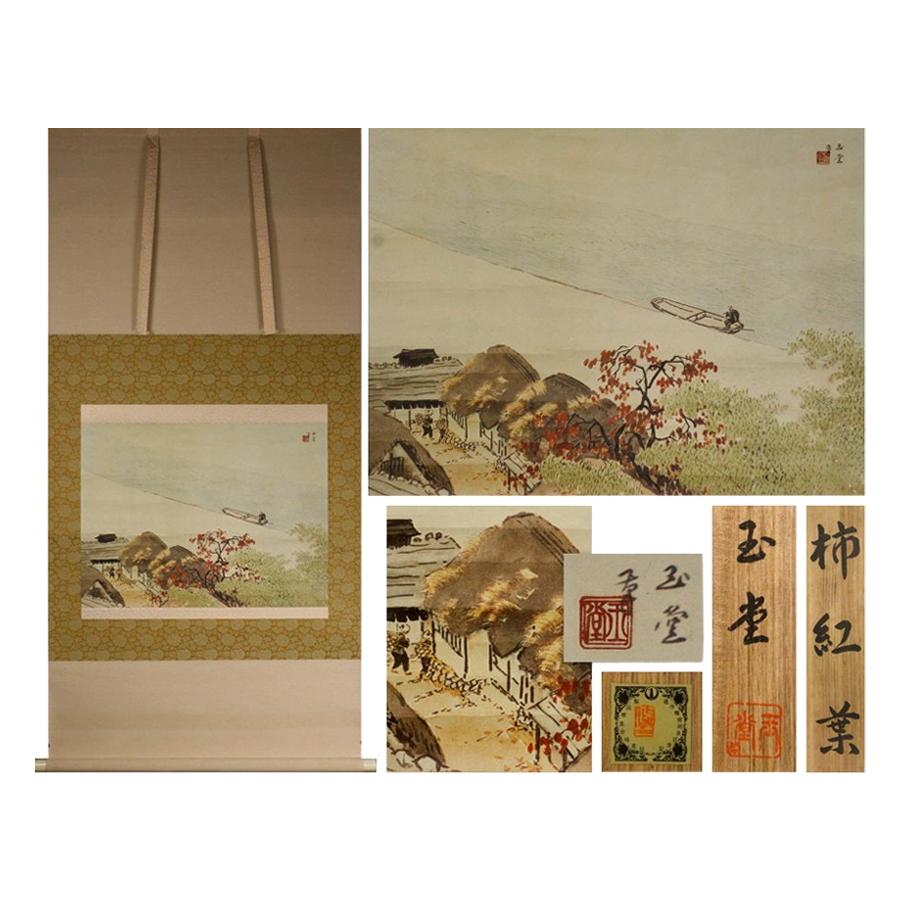Items Similar to Cherry Blossoms Showa Period Scroll Japan 20c Artist Mataichiro Isoda Nihonga st
Want more images or videos?
Request additional images or videos from the seller
1 of 5
Cherry Blossoms Showa Period Scroll Japan 20c Artist Mataichiro Isoda Nihonga st
About the Item
Name Kakejiku Calligraphy Kikuzu Paper Book Coloring Inscription (Shizushiro)
Size Axis: 195 cm in length, 42.5 cm in width, 131.5 cm in length, 31.5 cm in width *
Status I don't know the details of the author, but this product is hand-drawn, not printed.
The condition is good, but please note that there are light spots and wrinkles.
- Dimensions:Height: 76.78 in (195 cm)Width: 16.74 in (42.5 cm)Depth: 0.04 in (1 mm)
- Style:Showa (Of the Period)
- Materials and Techniques:
- Place of Origin:
- Period:
- Date of Manufacture:20th Century
- Condition:Wear consistent with age and use. Size Axis: 195 cm in length, 42.5 cm in width, 131.5 cm in length, 31.5 cm in width * Status I don't know the details of the author, but this product is hand-drawn, not printed. The condition is good, but please note that there are light spots and.
- Seller Location:Amsterdam, NL
- Reference Number:
About the Seller
5.0
Gold Seller
These expertly vetted sellers are highly rated and consistently exceed customer expectations.
Established in 2015
1stDibs seller since 2019
158 sales on 1stDibs
Typical response time: 8 hours
- ShippingRetrieving quote...Ships From: Amsterdam, Netherlands
- Return PolicyA return for this item may be initiated within 14 days of delivery.
More From This SellerView All
- Cherry Blossoms Showa Period Scroll Japan 20c Artist Mataichiro Isoda Nihonga StLocated in Amsterdam, Noord HollandBorn in Kyoto, Isoda Mataichirô studied painting at the Kyoto City Specialist School of Painting. After graduating there he studied Japanese-style painting with Kikuchi Keigetsu. Though primarily a painter he also made a number of woodblock designs for Unsôdô in Kyoto. is a very beautiful work in which the cherry blossoms in full bloom are drawn by the master, Mataichiro Isoda . "Mataichiro Isoda" Japanese-style painter. Born in Kyoto. Graduated from Kyoto City University of Arts, Department of Painting in 1914, and Kyoto City University of Arts in 1933 . Advance to the graduate school and complete. He studied under Keigetsu Kikuchi and was selected for the first time in the 8th Imperial Exhibition in 1945 with "Yin". Since then, he has been selected for the Imperial Exhibition, the Reorganized Imperial Exhibition, and the Nitten Exhibition almost every time. After the war, he was selected from the 3rd Nitten Exhibition in 1947, and "Chatei Liqiu" was selected at the 5th Exhibition in 1945. Since then, he will win an exhibition prize every time. 1956 Participated in the formation of Shirakosha by Uda Tekison, and exhibited at regular exhibitions until 1966 . Nitten party friend. During this time, he was a professor at Kacho Girls' High School from 28 to 1955. e specializes in flower and bird...Category
20th Century Japanese Showa Paintings and Screens
MaterialsSilk
- Artists Norikuni Kawamura, Showa Period Scroll Japan 20c Artist NihongaLocated in Amsterdam, Noord HollandAs you can see, it is a double box and a box with "Shokakuzu" written by Norikuni Kawamura. The "Shokaku-zu", which is composed of graceful textures, spreads its wings and flies, i...Category
20th Century Japanese Showa Paintings and Screens
MaterialsSilk
- Mountain Scene Showa Period Scroll Japan 20c Artist Kazuhide Saiuchi Nihonga StLocated in Amsterdam, Noord HollandAs you can see, this work was drawn by Kazuhide Sainai, who is known as a Japanese-style painter. The "Horaiyama-zu" is a very tasty view of trees, rocks, and mountains in the dista...Category
20th Century Japanese Showa Paintings and Screens
MaterialsSilk
- Artists Kawai Gyokudō Showa Period Scroll Japan 20c Artist NihongaLocated in Amsterdam, Noord HollandKawai Gyokudo (?? ??, November 24, 1873-June 30, 1957) was the pseudonym of a Japanese painter in the Nihongo school, active from Meiji through Showa period Japan. His real name was Kawai Yoshisaburo. Contents Biography Gyokudo was born in what is now Ichinomiya city, Aichi Prefecture, as the eldest son of a paper, ink and brush merchant. He went to Kyoto in 1887 to study under Kono Bairei of the Maruyama-Shijo school of painting. In 1896, he moved to Tokyo and he became the student of Hashimoto Gaho, of the Kano school. He also studied Western-style painting and developed a highly personal style, especially in the field of landscape painting. Gyokudo is noted for his polychrome and occasionally monochrome works depicting the mountains and rivers of Japan in the four seasons, with humans and animals shown as part of the natural landscape. Among his representative works are Futsuka zuki (“The New Moon”), Yuku haru (“The Departing Spring”), Mine-no-yu (“Evening at the Mountain Top”), and Bosetsu (“Snow in the Evening”). In 1898, Gyokudo joined with Okakura Tenshin and Yokoyama Taikan...Category
20th Century Japanese Taisho Paintings and Screens
MaterialsSilk
- Artists Kawai Gyokudō Showa Period Scroll Japan 20c Artist NihongaLocated in Amsterdam, Noord HollandKawai Gyokudo (?? ??, November 24, 1873-June 30, 1957) was the pseudonym of a Japanese painter in the Nihongo school, active from Meiji through Showa period Japan. His real name was Kawai Yoshisaburo. Contents Biography Gyokudo was born in what is now Ichinomiya city, Aichi Prefecture, as the eldest son of a paper, ink and brush merchant. He went to Kyoto in 1887 to study under Kono Bairei of the Maruyama-Shijo school of painting. In 1896, he moved to Tokyo and he became the student of Hashimoto Gaho, of the Kano school. He also studied Western-style painting and developed a highly personal style, especially in the field of landscape painting. Gyokudo is noted for his polychrome and occasionally monochrome works depicting the mountains and rivers of Japan in the four seasons, with humans and animals shown as part of the natural landscape. Among his representative works are Futsuka zuki (“The New Moon”), Yuku haru (“The Departing Spring”), Mine-no-yu (“Evening at the Mountain Top”), and Bosetsu (“Snow in the Evening”). In 1898, Gyokudo joined with Okakura Tenshin and Yokoyama Taikan...Category
20th Century Japanese Taisho Paintings and Screens
MaterialsSilk
- Artists Suiho Yano Showa Period Scroll Japan 20c Artist NihongaLocated in Amsterdam, Noord HollandAs you can see, it is a work of "Basho / Sparrow" drawn by Midori Yano. Under Basho, this work skillfully depicts the appearance of sparrows forming a flock and singing food. «Su...Category
20th Century Japanese Taisho Paintings and Screens
MaterialsSilk
You May Also Like
- Japanese Showa Two Panel Screen Blossoming Prunus TreeLocated in Rio Vista, CASerene Japanese Showa period two-panel folding byobu screen depicting a large spring blossoming prunus tree or plum tree. Beautifully painted with ink and natural color pigments on m...Category
20th Century Japanese Showa Paintings and Screens
MaterialsBrass
- Japanese Showa Period Peacocks Painted on SilkLocated in Rio Vista, CAColorful Japanese ink and color on silk Showa painting of a pair of peacocks. Vivid colors and beautiful details with a signature and seal on right side bottom. Framed in a midcentur...Category
20th Century Japanese Showa Paintings and Screens
MaterialsSilk, Plexiglass, Paper, Wood
- Japanese Showa Two Panel Screen Flowering Cherry by RiverLocated in Rio Vista, CAGorgeous Japanese 20th century Showa period two panel byobu screen depicting a delicate flowering cherry (sakura) tree by a meandering river or stream. Painted with ink and natural c...Category
20th Century Japanese Showa Paintings and Screens
MaterialsBrass
- Japanese Showa Period Folding Screen with Painted CranesLocated in New York, NYJapanese Showa period four panel folding screen finely painted with a theme of cranes in four elegant positions. The piece is signed and was made in circa 1950 in Japan. In great vi...Category
Vintage 1950s Japanese Showa Paintings and Screens
MaterialsFabric, Wood, Paint
- Early 20th Century Japanese Cherry Blossom Screen by Kano SanrakukiLocated in Kyoto, JPCherry Blossoms Kano Sanrakuki (1898-1981) Showa period, circa 1930 2-panel Japanese Screen Color, gofun and gold leaf on paper Against a backdrop of gold-leafed ground, the lichen covered trunk and branches of the life-sized cherry blossom tree reach out and beyond the confines of the pictorial surface. The overall composition has a feeling of flatness which draws emphasis to the surface and the three-dimensionality of the cherry blossoms. Painstakingly built-up layers of thickly applied shell-white gofun detail the voluminous blossoms and cover large areas of this tour-de-force of Japanese Nihonga painting. By simplifying the background, minimizing the number of colors and depicting the blossoms with such heavy relief, the artist has emphasized the stunning presence of the cherry tree. The type of tree depicted is the Yae-Zakura; a double-layered type of cherry blossom famed for its beauty and strength. When we think of Japanese cherry blossoms, the first thing that comes to mind is Somei Yoshino variety, which has a single flower with five almost white petals. This type is fragile and easily blown away by strong wind or rain. Most of the double-flowered cherry blossoms begin to bloom when the Somei-Yoshino falls, and the flowering period lasts longer than that of the Somei-Yoshino. Kano Sanrakuki originally studied painting at the Kyoto City Arts and Crafts School under the tutelage of Yamamoto Shunkyo...Category
Early 20th Century Japanese Showa Paintings and Screens
MaterialsGold Leaf
- Japanese Showa Period Mounted Screen Manchurian Cranes with PinesLocated in Rio Vista, CAImposing Japanese Showa period two panel byobu screen later mounted in a large gilt and ebonized wood frame. The screen depicts a pair of large redheaded Manchurian cranes flying ami...Category
20th Century Japanese Showa Paintings and Screens
MaterialsSilk, Wood
Recently Viewed
View AllMore Ways To Browse
Hand Drawn Vintage
Japan Book
Scroll Book
Vintage Cherry Art
Showa Period
Japanese Hand Scroll
Japanese Silk Painting 20th Century
Vintage Japanese Silk Screen
Cherry Artist
Screens Blossoms
Silk Asian Scroll
Vintage Cherry Blossoms
Japanese Showa Screen
Japanese Status
Japanese Paper Scroll
Nihonga Paintings
Silk Japanese Scrolls
Vintage Japanese Scrolls





